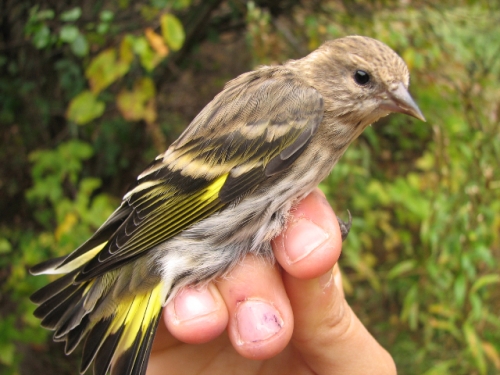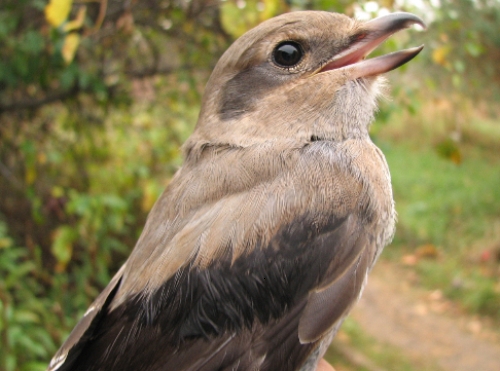|
McGILL BIRD OBSERVATORY |
||||||||||||||||||||||||||||||||||||||||||||||||||||||||||||||||||||
Welcome
to the McGill Bird Observatory weekly report.
Click here for a complete listing of our archives.
Banders-in-charge: Barbara Frei, Marie-Anne Hudson, James Junda Notes: After an extremely busy last two weeks, the reduced volume of birds in the nets during week 11 provided a welcome respite for us - though actually the total of over 500 birds banded still ranks among our busiest ever. With fewer birds on the move we were able to resume operating our full set of nets, but instead high winds and light rain on several mornings limited our net hours for the week. Highlights this week included three species banded for the first time this fall - Red-winged Blackbird, Northern Shrike and Pine Siskin! This marked the first time that we banded Pine Siskins at MBO during our migration monitoring season – previously the only occasion we banded any was a single day in February 2006 as part of our winter population monitoring efforts. We were therefore delighted to have a large flock of these finches on site this week, especially since 14 of them found their way into our nets! Additional highlights included our first Rough-legged Hawk of the year, and a new species for the site – a Ruffed Grouse seen along the census trail. This brings us to a whopping 197 species seen at MBO so far – just 3 shy of 200! What could the next 3 species be? Likely candidates (based on sightings in adjacent areas over the past couple of years) include Great Egret, Red-bellied Woodpecker, Tufted Titmouse, and Carolina Wren ... but we'd also be happy to have some more exotic surprises help us reach this milestone. The diversity of species observed and banded dropped considerably in comparison with last week, as is expected in mid-October. Most of the warblers have finished passing through, except of course the Yellow-rumped Warbler. Despite a large drop from 649 banded last week to 209 banded this week, it remained firmly ensconced in the number 1 position on the list of most frequently banded species for week 11. This continues a remarkable season for warblers - every week this fall, a warbler species has topped this list (Yellow Warbler in week 1, American Redstart in weeks 2-3, Magnolia Warbler in weeks 4-7, and Yellow-rumped Warbler in weeks 8-11). With even the Yellow-rumped Warblers finally tapering off, it seems likely that non-warblers may finally dominate over the final two weeks of the fall, but it has been an impressive streak in any case, considering how dominant kinglets and sparrows have been in past fall seasons. American Robins jumped to the number 2 spot this week with a hundred banded, and also moved up to the top of the list of most frequently observed birds. Flocks of 200 or more individuals can be seen most mornings, with their shrill cries and melodious snippets of songs echoing through the large cottonwood trees next to the station. All our helpful extractors can attest to the abundance of robins all too well, as they went home most days with purple-stained fingers (and clothes), thanks to the loose bowels of these birds and their preference for eating the purple-fleshed buckthorn berries so common at MBO. The remainder of this week's top 10 birds banded were of relatively smaller numbers and included four sparrow species, a modest movement of Ruby-crowned Kinglets, a fraction of the Pine Siskin flock, Common Grackles, and for the second week in a row, Hermit Thrush.
Among the top 10 species observed, there was a decrease in the number of individuals observed overall, save for the robins. Pine Siskins made their first ever appearance on this list, while European Starling was the only other species added since last week. Canada Geese are tapering off, while the mixed blackbird flocks remain fairly sizeable, but are largely staying up high and flying overhead, rather than spending much time within the site itself.
|


